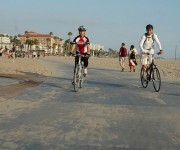Santa Monica’s bike freeway was so packed last Fourth of July that the Coast Guard had to issue a travel advisory.Photo: Elly BlueElly Blue is on a monthlong Dinner & Bikes tour around the western U.S., along with Portland bike filmmaker Joe Biel and traveling vegan chef Joshua Ploeg. This is one of her thrice-weekly dispatches from the road about bicycle culture and economy. Read them all here.
Santa Monica, Calif.: Spend 10 minutes with Gary Kavanagh — a blogger, advocate, and ubiquitous presence in Santa Monica’s bike scene — and you’re apt to get an earful about the new light rail line and bike path being built into town, the new Bike Master Plan that the city council may soon approve, or the amount of public space in the city that is dedicated to car parking. But look at Kavanagh’s pictures from our latest Dinner & Bikes event on Saturday night, and you’ll mostly see shots of our merch table. Basically, it’s a traveling bookstore stocked with titles about bikes, urban gardening, and radical movements, as well as bike-themed stickers and t-shirts.
Santa Monica is rich in bike riders, bike lanes, bike dreams, and — perhaps most key — bike funding. But, as Kavanagh’s enthusiasm suggests, it is also a city without a decent bookstore.
Cynthia Rose, who organized the event on behalf of local bike advocacy powerhouse Santa Monica Spoke, sighed about the recent demise of an independent arts bookstore that closed when its rent skyrocketed. The Borders here closed when the mega company went bankrupt. All that remains are a few spiritual bookshops and one last, struggling chain store.
It’s a bleak landscape for book lovers, and our guests that night were obviously starved for the printed word. As soon as they began to arrive, the merch table was as mobbed as the bike path down by the beach was last Fourth of July weekend, when the Coast Guard had to issue its first bicycle travel advisory. The crowd of book and bike enthusiasts never let up, even during our program.
This paucity of places to buy books, especially the edgier nonfiction fare we stock, is hardly unique to Santa Monica, but it’s surprising to find in such a well-heeled place. It’s a sobering sign that wealth and grand bicycle visions cannot insulate a community from the troubles of a car-centric nation.
Small, independent bookstores have largely gone the way of the dodo, thanks to big-box bookstores that began a race to the bottom in the early 90s, chopping their prices beyond what even they could sustain. They ruined the party for everyone, including smaller rivals, customers, and ultimately themselves. These days, most Americans have to go online or get in a car in order to buy a book, and the money used to buy that book — and the gas burned to get to the store — flies straight out of their communities.
Suburban, big-box behemoths took out more than just bookstores: Mom-and-pop hardware stores, pharmacies, and restaurants have all seen their business crater. The process devastated the fabric of urban neighborhoods and the small businesses that hold them together. Bookstores were hit particularly hard because they sell luxury items whose tiny profit margins require moving low-priced units in huge numbers.
It’s a bummer of a story, but the natural consequence of giant chains collapsing under the weight of their own price cuts offers hope. The demand we found in Santa Monica for independent bookstores and underground publishers means it’s only a matter of time before someone rises to fill the space left after the big-box crash. It’s a trend that parallels the rise of the bicycle movement: As society and individuals stagger under the ever-escalating costs of building and maintaining roads, filling up our gas tanks, and suffering the health and social consequences of auto-centric suburbs, many of us have turned back to the simplicity of the bike.
You could say that cars killed the independent bookstore: They fell prey to the same nexus of industrial, financial, and political maneuvering that created our car-oriented landscape. But bicycling could help bring them back. Right now, it feels good to know our tiny rental car carries both bikes and the promise of a new iteration of urbanism — one where everyone can afford to both travel at will, sit, and read a good book.



